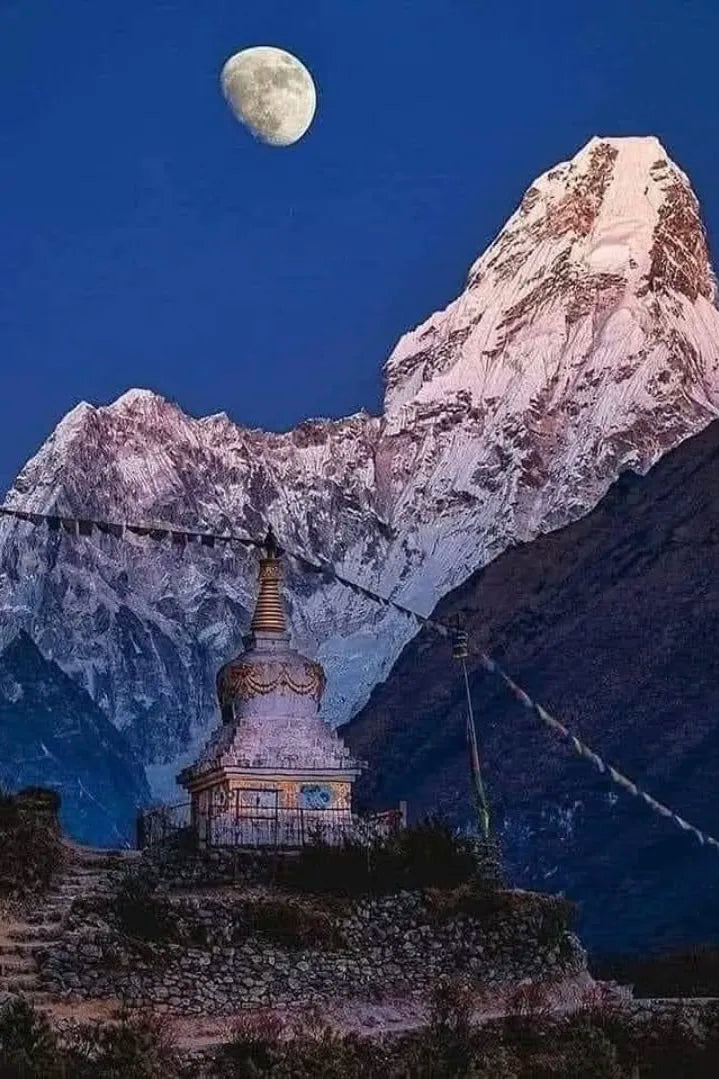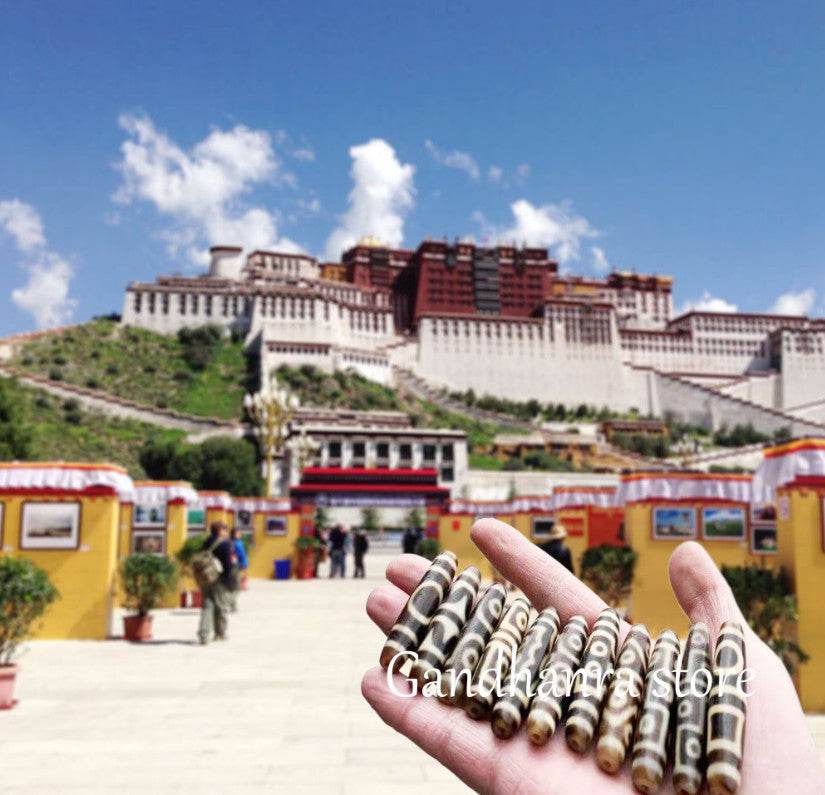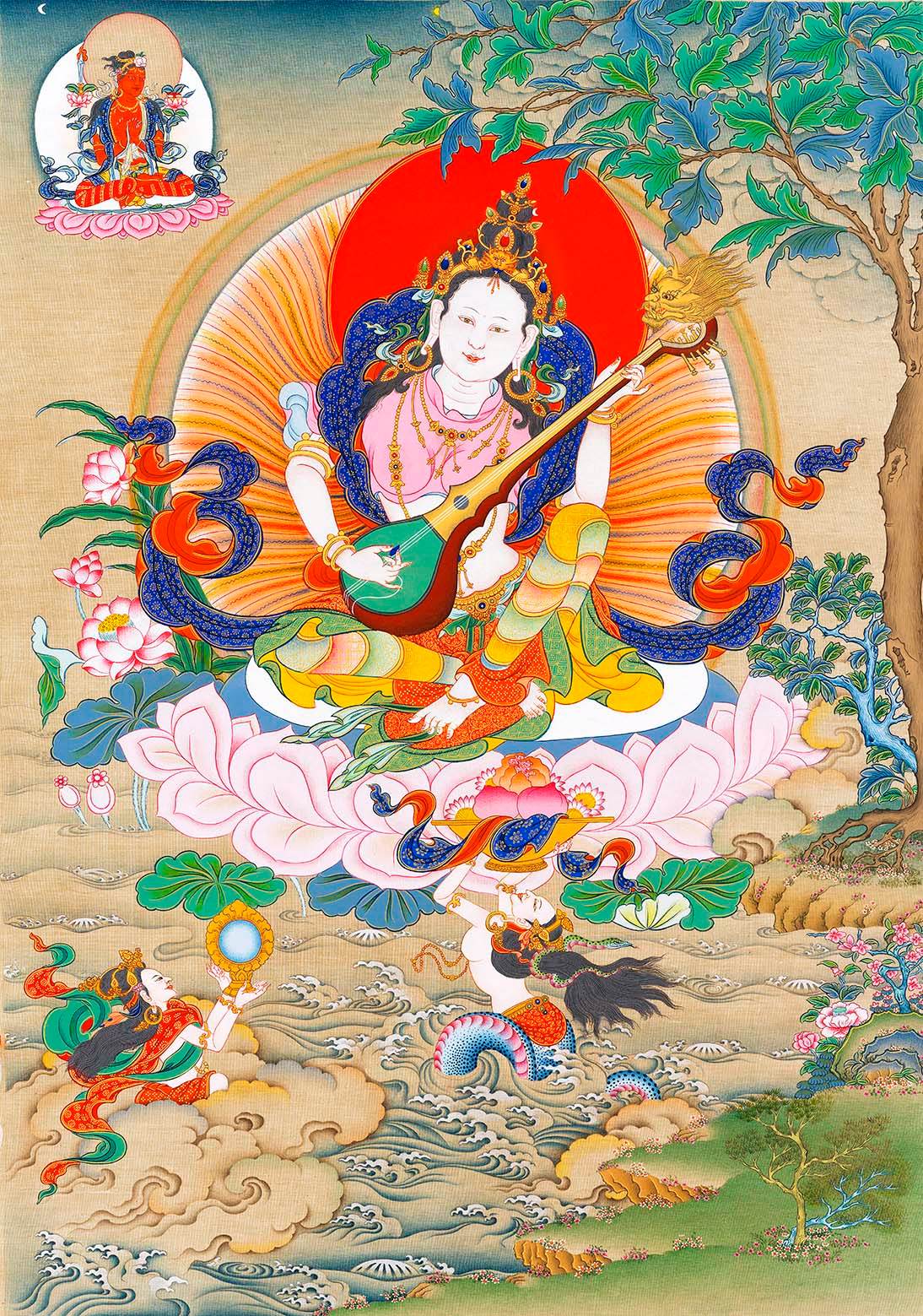
A Snow Leopard Tracking Journey ▎Awakening Expedition

In 1982, at the foot of Mount Ama Dablam, a tranquil village.
Image: National Geographic
The Call of the Wilderness
In the autumn of 1972, to gather data on the wildlife of the Tibetan Plateau, wildlife biologist George Schaller invited his writer friend Peter Matthiessen to join him on a journey to northwestern Nepal to study the Himalayan blue sheep (bharal).

In the mid-1960s, Dolpa region.
Image: National Geographic
Previously, Matthiessen had heard that there were significant numbers of blue sheep near Shey Monastery in the Dolpa region (due to the area's long-standing traditions and the monks' strict adherence to the precept of non-violence, the animal populations were well-protected there). And where the blue sheep were most active, snow leopards were sure to be present. To Matthiessen's knowledge, only two Westerners had seen this rare and beautiful animal in the past twenty-five years, and Schaller was one of them. Eager to catch a glimpse of this "mystical creature of the snow-capped mountains," Matthiessen gladly decided to accompany Schaller on the journey the following autumn.

The snow leopard on the cover of Matthiessen's work.
Image: amazon
At the outset of their journey, Matthiessen's understanding of their destination was limited and vague. Having been immersed in the modern Western civilization for so long, the current state of the distant Himalayan world remained shrouded in a veil of mysterious legend to him.

A 1950s Kathmandu travel poster
Depicting a local woman pushing open a door
The divine and majestic Himalayas bathed in golden morning light.

A 1960s Kangchenjunga travel poster.
Image: Pinterest
The two set out from Kathmandu in September of the following year. This journey would take them from south to north across the entire Himalayan range, and after nearly two months of arduous trekking, they would finally reach their destination, Shey Monastery (Crystal Monastery). Unlike Schaller, whose purpose was scientific research, Matthiessen was seeking "to delve into the high mountain sanctuary in search of something still unknown, and like the yeti, perhaps something that might be lost in the pursuit."

A mountain monastery nestled deep within a secluded valley.
Photo: worldexpeditions
From the very first day of their journey, Matthiessen began meticulously documenting his daily experiences, observations, and reflections in the form of a diary. These records were eventually compiled into the classic work "The Snow Leopard: A Pilgrimage of the Heart," which has been acclaimed by critics as "a seamless blend of nature writing and spiritual Zen insights" and continues to be a bestseller to this day. For this work, Matthiessen was once again honored with the prestigious National Book Award.

Matthiessen in his study.
Photo: Esquire Classic
Pilgrimage of the Heart
In the depths of the mountains, far removed from modern civilization, the concept of time is absent. Matthiessen felt as though little had changed since the time of Siddhartha Gautama in the 6th century BC. The beliefs and ways of life of the people here remained as slow-paced, quiet, and mysterious as ever. When the journey passed through Pokhara, "the last outpost of the modern world," Matthiessen removed his watch, for to him, "the time on the watch had lost all meaning here." "We seemed to be a century away from the mundane world."

The landscape of Pokhara in the 1970s
The sacred Machapuchare peak is prominently visible in the distance
Photography: Sridhar Manandhar
Image: VintageNepal
Without news, without telephone or mail, without the usual secular entertainments and material temptations, and even without the reference points of time, space, and people, the important matters in life that were once thought to be indispensable suddenly simplified to the mere instinctual activities of eating, walking, observing, daydreaming, solitude, and sleeping. If one did not consciously force oneself to write or think, it seemed as if even any mental activity was unnecessary.
 Matthiessen in Writing. Image: The New York Times
Matthiessen in Writing. Image: The New York Times
"We live like the locals, retiring at sunset and rising at dawn." Here, there is no need for cognition, no need for planning or organizing, just acting on present intuition. Removing the barriers of defense or self-consciousness, responding automatically to all things, just like the flowers deep in the valley that are always following the natural rhythms and cosmic order, completely immersing themselves in growth and completing the practice of this cycle of life in the endless cycle of existence. And magically, life can continue as usual in this situation and state.
After stripping away layers of overload and simplifying, life can be so simple and light. The Western concept of heavily relying on reason and logic, accustomed to linear thinking, begins to loosen, and the lifestyle of strategizing and planning is gradually adjusted to only focusing on the present moment and awareness, revealing the essence of life and life itself. Just like a bright moon revealing itself from behind the clouds, shining with a clear brilliance that fills the heart and soul with joy and tranquility.

"I have returned to my inner self."
Photography: Nguyện Văn Kim
To onlookers, this journey may seem lonely and harsh. Especially as winter approaches, the increasingly harsh climate in the Himalayan region brings unexpected challenges and obstacles to the journey. Through a haiku written by Char, we can catch a glimpse of their situation: "Alone on a mountain path, coolies chatting softly, magpies dancing ahead." However, for two individuals who have lost interest in modern human civilization, this journey is a rare opportunity for a journey of introspection, a spiritual pilgrimage. Matthewson calls it a "fragrant journey."

Amadablam Peak
Photography: @black.sails_
The true essence of intuitive existence.
The so-called soul-cleansing journey of meditation is now familiar to people, and pursuing inner peace has become a fashionable trend. Areas where few people venture and have not been fully developed commercially can overnight attract countless tourists after being exposed in the media. The convenience of material goods and transportation allows any soul that has been tormented in the hustle and bustle, restlessness, and anxiety to land anywhere in the world at any time. However, the inner obstacles caused by rigid and closed consciousness can once again cloud any piece of pure land, while a clear-minded soul can find a peaceful place in any hustle and bustle of the world.

1980 Mustang region A woman is intently weaving.
Photography: Mani Lama
Everything is a dialectical existence. Just like a river with no one-sided bank, or a hand with no one-sided face. When we see too much longing for utopia and paradise on social media, we must know that this is just a self-deceptive game. This world certainly has utopias and paradises, but they must be understood and accepted deeply on all sides, recognizing that the positive and the negative are inseparable and cannot be separated, completely eliminating distinctions in the mind. When one reaches this level, they will no longer view and understand everything with a logic of opposition. Everything will be completely different. It is a completely new quality.
Matthewson's travel experiences have become a classic that has been selling well for decades, providing valuable insights to the soul, because that new quality emerged gradually in his heart along with his travels. It is not just a superficial touristic experience. During his journey, he achieved spiritual growth.




A glimpse of the Chinese and foreign editions' covers of "The Snow Leopard."
True meditation does not depend on seeking a space separate and detached from the mundane world. There is no place of silence that exists as an object in the world. At the beginning of the journey, perhaps Matthiessen had not truly and clearly realized this level of understanding, and if he did, it was only a theoretical understanding based on his readings, far from the intuitive experience gained with an open mind. Because before this journey, he had already had two to three years of meditation experience and had read a considerable portion of representative Eastern philosophical works.
This is consistent with the idea of "renouncing desires, contemplating well, and realizing the truth—the true essence of intuitive existence." Siddhartha Gautama abandoned the ancient epic philosophy, believing that "such tranquility lacks the supreme truth." He then turned to engage in the midst of activity. In fact, Matthiessen's journey was a rare empirical validation in real life of the Zen thoughts he had absorbed from a purely theoretical level in the past.

The Teaching Under the Tree
Image: Pinterest
Whether reminiscing about his wife taken by illness or longing for his son in a foreign land, towards others, towards himself, and towards all things, the confluence of causes and conditions propelled and facilitated his enlightenment with a completely new and open perspective and mindset. From this thick diary, it is evident that Matthiessen's introspection and the progression of his journey were inseparable. The so-called purification of the soul is, in fact, nothing more than becoming an awakened being, fully aware of each present moment of life with an open consciousness.
Truly living in the present moment.

A Sherpa guide in 1969.
Photography: Noel Zinn
"He has the wild yet wise eyes of a yogi monk. He exudes an inner tranquility, likely related to his spiritual attainments... He seems like a hazy figure from a past life, as if we have known each other for a long time... I intuitively feel that his presence here is not accidental, and I am uneasy in my heart, while he takes our special connection for granted. I often sense his gaze, as if he is here to protect me... His gaze is frank, calm, kind, without any judgment, yet when I look into his eyes as if into a mirror, I feel the emptiness, greed, anger, and folly within myself." He "possesses the wisdom of what Tibetans call a 'mad traveler': unfettered and free."




Nepalese porters in 1968.
Photography: Rabi Sharma Khanal
This is Tukten, the Sherpa guide who left a deep impression on Matthiessen during the journey. He was always willing to do his best in every task and often extended a helping hand for others' trivial matters beyond his own duties. Matthiessen also described a local grandmother named Sonam, who lived in a quiet village and was like a wise elder.








Nepalese Children and Women, 1972
Photography by Nick DeWolf
"On the way down the mountain, I stopped outside Mrs. Xiaocun Sonam's yard for a while. She was wearing tattered clothes stained black with coal smoke and rough spun boots, with coral-colored beads left over from her girlhood. She stretched out her legs sitting on a pile of dried cow dung, diligently weaving a wool blanket on a makeshift loom propped up on stones and sticks, using old straw shoes to tighten it against the stones. The wool blanket she was weaving had a delicate and elegant pattern, showing that even rural old ladies understood design. I admired her sudden smile, strong back, and fearless dirty skin. Many years ago, she was once a rosy-cheeked little girl, but now she worked hard in her twilight years. Under the dim half-moon, the chill was setting in and soon night would be upon us. She would quietly slip through her narrow door to eat a bit of barley. Every day at dawn, she would go out to collect cow dung, what did she dream of at night? Perhaps she was smarter than that, not thinking about it at all, just busy surviving, like a wolf; survival was her way of meditation."

Photography by Eric Valli
They embody their beliefs in every moment of daily life. It is not about the repetition of rituals and doctrines day after day, but simply about "nurturing inner awareness" and living genuinely and sincerely in the present moment.
They not only face a person, but also a mountain, a lake, a blade of grass, a bird, or an insect, and they can engage in a fully responsive interaction with the clear intuition of the moment. They do not judge or differentiate with the activity of the mind, but rather carefully feel the natural existence of each entity, in oneness with the universe.

"They are fully immersed in every action,
not as a result of consciousness, but naturally."
Photo: Pinterest
So he wrote in his diary, "Wind, swaying grass, sunlight. The dying blades of grass and the call of birds flying south in the sky are no more fleeting than rocks, of course not more eternal than rocks—they are all the same. The mountain gradually quieted down, my body melted into the sunlight, tears that had nothing to do with 'me' flowed. Why the tears flowed, I do not know."
"The mica on the road and the scattered stones sparkled, a yellow and gray-blue feather lay there, not just left by a bird. I suddenly had an unexplained sharp intuition, always feeling that in this silver-white road, in this feather, in the sound of wood and leather boots, in breathing, in the rhythm of sunlight, wind, and water flow, in the mountains and rivers that do not distinguish past and future, in this moment, in all moments, 'impermanence' and 'eternity,' 'death' and 'life' are all inseparable."

Photo by _vzvsky
The Revelation of Crystal Mountain
The front page of the work commented on Matthewson's writing, "His mastery of the snow-capped scenery is superb and exquisite, with just a few words, he brings Nepal's mountains vividly to life, exuding a pure and crisp atmosphere. Behind this scenery, there is an overflow of thoughts, sometimes melancholic, sometimes light-hearted. After the ups and downs of a slow journey, all paths lead to a tranquil and clear enlightenment."
One of the misconceptions of Western culture about Zen Buddhism is that it implies an escape from reality. In fact, Zen Buddhism encourages people to live in the present - to "bravely exist in this moment." It emphasizes the experience of awakening, living as an awakened observer who directly faces reality and transcends attachment to the past and future, focusing on clear awareness and contemplation of each present moment. It is not about seeking a pure land away from the world, but about finding purity within the world - "awake without leaving the world."
 A 1960s Bodh Gaya travel poster.
A 1960s Bodh Gaya travel poster.Photo: Pinterest
Ancient Eastern philosophy often reaches the essence of things through intuition and inner insight, rather than theory and logic. In contrast, Western rational thought systems, which focus more on logic and analysis to explore the essence of things, sometimes tend to view Eastern knowledge as mystical and abstract because it goes beyond the realm of reason and logic. However, ancient Indian philosophy has long regarded life as an incomprehensible mystery, rather than a problem that can be easily understood through explanation and analysis. Perhaps this is where the beauty of life lies.
As the ancient Zen saying goes, "Not a single snowflake falls in the wrong place." Everything follows its own rhythm of life, and everything is as it is. Training one's own mind and heart is more important than enlightenment through knowledge. "Break free from preconceived notions and evidence-based judgments. Bring the awareness of 'now' into every aspect of daily life." Embrace the precision, openness, and wisdom of the present moment.
 During the busy farming season, an old woman.
During the busy farming season, an old woman.
In his diary, Matthewson said, "The mystery of the mountains lies in the fact that the mountain simply exists, like me, but the mountain exists purely and simply, while I am not. The mountain has no 'meaning,' it is meaning itself; the mountain exists. The sun is round. Life resounds through my whole body, and the hills do the same, and when I hear it, we share something. I understand all this, not with my mind but with my heart, I know how futile it is to try to capture the inexpressible, and I know that when I reread these records in the future, my state of mind will change, leaving only empty words and symbols."
And this is precisely the precious realization that Matthewson gained on this journey, perhaps the only one of his life. But even holding onto this realization is of no use. As his travel companion Charle wrote in a haiku, "The burdened cloud of Han, black claw marks in the snow, fleeting emptiness." "If you grasp at emptiness, emptiness becomes a barrier."
 Fish Tail Peak
Fish Tail PeakPhotography: Khim Lamichhane Kazi
Everything is here.
"I am saddened by this, so I look around, wanting to etch the precious feeling of Shey in this diary, knowing full well that all efforts are in vain; I must gladly let go of the beauty of this place, just as I let go of the rocks in the stream. Frustrated by the inadequacy of words, I write in my diary; but a single strand of wool, a withered branch of immortelle, contains more of the essence of Shey than all my diaries. In striving to immortalize what I thought I understood, I missed the core meaning."
The human perception of beauty or the habitually accepted concept of beauty is a distinction from ugliness, yet this is an illusion. True beauty stems from wholeness. It is beautiful because of its completeness. Ugliness arising from a holistic consciousness is another form of beauty. Just as a person's life is a complete experience composed of all the inevitable states and stages of youth, aging, sickness, health, vitality, and dullness, a journey begins with departure and moves towards the return, and the cycle of a year is beautiful because of the changing seasons. One should cultivate a holistic consciousness.

Sometimes, even when a person has traveled a great distance, their heart still looks back and refuses to fully open up, and remains lost in a corner of gains and losses. Compared to the transformation of physical distance, it is the crossing of spiritual obstacles that allows the heart to once again become clear and pure, giving the journey a more important and profound meaning. While Matthew's journey may have concluded, his journey as a seer is endless. Like the water flowing back into the ocean a thousand times, he has realized that all things are one with the universe, and it is necessary to care for the survival of the whole, to return to his inner self, to let intuition transcend cognition, and that everything lies in this.

Photograph by Kahil Gibran






